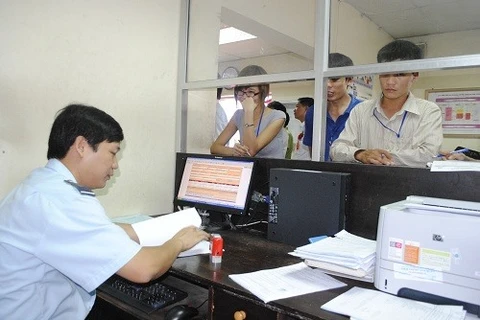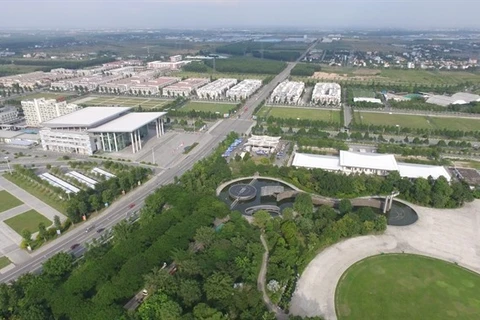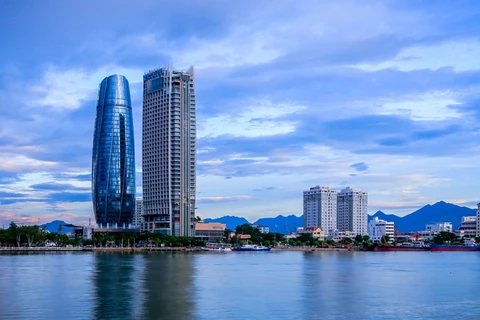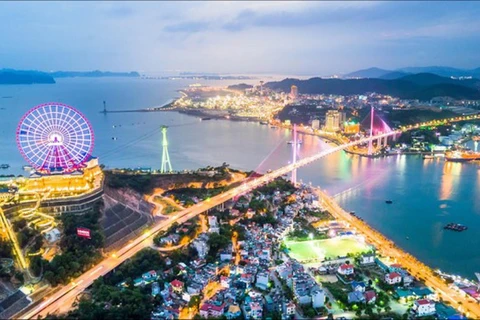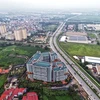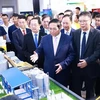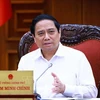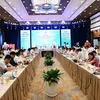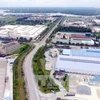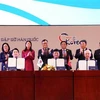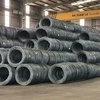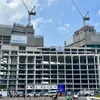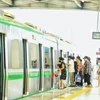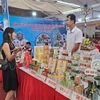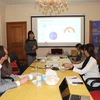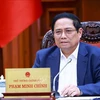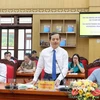Hanoi (VNS/VNA) - The ICT (information and communication technology) reference framework for the development of smart cities (version 1.0) has been issued by the Ministry of Information and Communications as a basis for localities and businesses to develop smart city projects.
The ICT reference framework is a set of functions to link smart regions, applications, and urban services to ensure consistency and synchronisation in smart city development, according to Decision 829/QD-BTTTT on the ICT reference framework issued on May 31 by the Ministry of Information and Communication.
The ICT reference framework for developing smart cities is the basis for building and implementing smart city plans, smart city development investment projects, plans on leasing smart city services and the ICT architecture of smart city development.
Building of the ICT reference framework is one of the tasks included in Decision 950/QD-TTg on sustainable development of smart cities in 2018-25, issued on August 1, 2018 by the Prime Minister.
Priority fields and services for smart city development include smart city management, water systems, waste collection and treatment systems, grids, lighting systems, traffic systems, education and healthcare.
In recent years, many provinces and cities in Vietnam have started plans to build pilot projects on smart city development such as Ho Chi Minh City, Hanoi, Da Nang, Thua Thien-Hue, Binh Duong, Da Lat, Thai Nguyen, Hai Phong, Quang Ninh and Can Tho.
However, the localities have not been able to draw upon standards like the ICT reference framework in the process of developing their smart city projects.
Vietnam has taken the first steps on the journey towards smart cities, according to Savills Vietnam, a foreign property service provider in Vietnam.
“At the city level, there have efforts made by local authorities to create a smart city, including utilities, power and public facilities,” said Matthew Powell, Director of Savills Vietnam’s Hanoi branch.
“At the project level, developers and buyers have shown strong interest in how to make buildings safe and smart from the management and operation perspective, including security systems, internet connectivity, electricity and environmental factors. Within the home itself, we of course have internet of things and integrated smart assistants provided by third parties.”
Powell believes learning, research and testing are necessary to building smart cities successfully and sustainably.
“In my opinion, it is about looking regionally and working with an international consultant to find the right direction and products for development.”
“Developers have a lot of options regarding where and how smart technology could be applied, but not all of them are useful and suitable for the property and Vietnamese customers. As such, developers need to do their research and examine these smart features to find the right supplier for hardware and software, with long term technological impacts for the property product, the project and customers, not a frivolous gimmick for marketing or sales purposes.”
According to Jones Lang LaSalle Incorporated (JLL) Vietnam, a commercial real estate services firm, the smart townships launched by developers have achieved high sale rates. Since it first launch in 2016, the Hanoi property market has welcomed more than 10,000 smart units with a sale rate of approximately 70 percent on an average.
JLL expects more smart township projects to come to the market in the near future. These include BRG Smart City in Hanoi, Ecopark Smart City in Huong Yen province, Dragon Smart City in Da Nang and Thu Thiem Eco Smart City in HCM City.
These projects promise all types of convenience – smart landscape planning with advanced IT infrastructure to build a smart and eco-friendly neighbourhood where residents can enjoy integrated services within a walkable distance.
Undeniably, smart townships are gaining significant popularity that has directly led to a series of changes in Vietnam’s property market. While it could be a good option for investors and individual buyers, the latter should be aware that different developers are providing different technology solutions to varying degrees.
The Vietnamese property market is starting its journey where both public and private sectors are changing the urban landscape to incorporate technology that could enhance the living environment, it said.
JLL expects that for future real estate developments, “stay smart” will not just be a trend but also a “must-have”.
The adoption of new technology platforms generates new and more easily-accessible market data, which is key for overall real estate transparency in Vietnam, it said.
HCM City and Hanoi have some of the youngest and most tech-savvy populations in the world. The country’s population is young, with 70 percent of its citizens below the age of 35, while they are highly literate with a 98.5 percent literacy rate among those aged 15 to 35, JLL said.
The Visa Consumer Payment Attitudes Study found that 84 percent of Vietnamese respondents shop online at least once a month, trailing closely behind Thailand at 85 percent. Developers of new residential projects are leveraging this trend and building smart townships to attract young buyers, according to JLL. — VNS/VNA
The ICT reference framework is a set of functions to link smart regions, applications, and urban services to ensure consistency and synchronisation in smart city development, according to Decision 829/QD-BTTTT on the ICT reference framework issued on May 31 by the Ministry of Information and Communication.
The ICT reference framework for developing smart cities is the basis for building and implementing smart city plans, smart city development investment projects, plans on leasing smart city services and the ICT architecture of smart city development.
Building of the ICT reference framework is one of the tasks included in Decision 950/QD-TTg on sustainable development of smart cities in 2018-25, issued on August 1, 2018 by the Prime Minister.
Priority fields and services for smart city development include smart city management, water systems, waste collection and treatment systems, grids, lighting systems, traffic systems, education and healthcare.
In recent years, many provinces and cities in Vietnam have started plans to build pilot projects on smart city development such as Ho Chi Minh City, Hanoi, Da Nang, Thua Thien-Hue, Binh Duong, Da Lat, Thai Nguyen, Hai Phong, Quang Ninh and Can Tho.
However, the localities have not been able to draw upon standards like the ICT reference framework in the process of developing their smart city projects.
Vietnam has taken the first steps on the journey towards smart cities, according to Savills Vietnam, a foreign property service provider in Vietnam.
“At the city level, there have efforts made by local authorities to create a smart city, including utilities, power and public facilities,” said Matthew Powell, Director of Savills Vietnam’s Hanoi branch.
“At the project level, developers and buyers have shown strong interest in how to make buildings safe and smart from the management and operation perspective, including security systems, internet connectivity, electricity and environmental factors. Within the home itself, we of course have internet of things and integrated smart assistants provided by third parties.”
Powell believes learning, research and testing are necessary to building smart cities successfully and sustainably.
“In my opinion, it is about looking regionally and working with an international consultant to find the right direction and products for development.”
“Developers have a lot of options regarding where and how smart technology could be applied, but not all of them are useful and suitable for the property and Vietnamese customers. As such, developers need to do their research and examine these smart features to find the right supplier for hardware and software, with long term technological impacts for the property product, the project and customers, not a frivolous gimmick for marketing or sales purposes.”
According to Jones Lang LaSalle Incorporated (JLL) Vietnam, a commercial real estate services firm, the smart townships launched by developers have achieved high sale rates. Since it first launch in 2016, the Hanoi property market has welcomed more than 10,000 smart units with a sale rate of approximately 70 percent on an average.
JLL expects more smart township projects to come to the market in the near future. These include BRG Smart City in Hanoi, Ecopark Smart City in Huong Yen province, Dragon Smart City in Da Nang and Thu Thiem Eco Smart City in HCM City.
These projects promise all types of convenience – smart landscape planning with advanced IT infrastructure to build a smart and eco-friendly neighbourhood where residents can enjoy integrated services within a walkable distance.
Undeniably, smart townships are gaining significant popularity that has directly led to a series of changes in Vietnam’s property market. While it could be a good option for investors and individual buyers, the latter should be aware that different developers are providing different technology solutions to varying degrees.
The Vietnamese property market is starting its journey where both public and private sectors are changing the urban landscape to incorporate technology that could enhance the living environment, it said.
JLL expects that for future real estate developments, “stay smart” will not just be a trend but also a “must-have”.
The adoption of new technology platforms generates new and more easily-accessible market data, which is key for overall real estate transparency in Vietnam, it said.
HCM City and Hanoi have some of the youngest and most tech-savvy populations in the world. The country’s population is young, with 70 percent of its citizens below the age of 35, while they are highly literate with a 98.5 percent literacy rate among those aged 15 to 35, JLL said.
The Visa Consumer Payment Attitudes Study found that 84 percent of Vietnamese respondents shop online at least once a month, trailing closely behind Thailand at 85 percent. Developers of new residential projects are leveraging this trend and building smart townships to attract young buyers, according to JLL. — VNS/VNA
VNA
